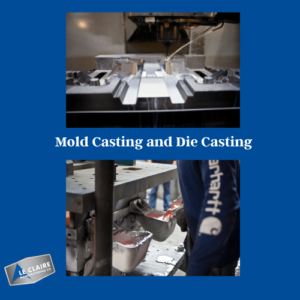Choosing the right casting process involves considering what the design needs and the economics of each possible route. It’s often an iterative process as casting method influences yields, part design and secondary finishing operations. A better understanding of the strengths of each method helps reduce the number of options and saves time.
The main methods for producing near-net-shape aluminum parts are sand casting, permanent mold casting, and die casting. Those last two are often confused or misunderstood. We’ll compare them here, along the way identifying die casting advantages and permanent mold casting advantages.
Permanent Mold Casting vs. Die Casting
Both permanent mold and die casting use steel molds to form a cavity that contains the molten aluminum as it cools. It’s these molds that distinguish the processes from sand casting, where a new cavity is formed in sand every cycle. Die coatings protect the steel against the abrasive effect of molten metal.
The major difference between the two steel die techniques is how the metal gets into the tooling. In permanent mold casting, metal flows into the cavity from a reservoir. A gate controls the speed of flow to reduce turbulence. Typically, the die will be designed to fill from the bottom or side with the riser at the highest point.
After filling, the metal is given time to freeze before the mold is opened and the part removed. Features such as internal galleries are created by placing inserts into the mold before it is closed.
In contrast to gravity-fed permanent mold casting, with die casting, metal is forced into the cavity under pressure. This makes it very similar to plastic injection molding. As with permanent mold casting, once the metal solidifies, the mold opens and the cast forms are removed.
Die Casting Advantages
- Excellent finish of the as-cast surface, better than 125 microinches. May need little-to-no secondary machining and finishing.
- Can maintain very tight geometric tolerances, including thin walls.
- Faster process part-to-part than permanent mold casting, which helps lower unit costs on longer runs.
- Equipment often needs less floor space than that for permanent mold casting. (Of greater concern to the caster than the casting buyer, but may help lower overhead costs allocated on the basis of area occupied.)
Permanent Mold Casting Advantages
- Permanent mold dies are generally less complex and therefore less expensive than those needed for die casting.
- Surface finish usually in the range of 125 to 300 microinches, meaning that secondary machining is not always required.
- Process produces less porosity than die casting, so finished part yields will be higher.
- Castings have higher strength.
Consider Volumes and Part Characteristics
When you need larger quantities, the speed of permanent mold and die casting makes it economic to pay for metal mold tools. Die casting tools tend to be more expensive than those for permanent die, but the process yields a more accurate part with thinner walls and smoother surfaces.
The permanent mold process is a little slower than die casting, but the tools are less expensive. Also, and often a deciding factor, the resulting parts are stronger with less porosity.
Talk to the Specialists
If you need aluminum castings, LeClaire Manufacturing can help. As permanent mold and sand casting specialists, we can guide you through process selection, undertake tooling design, and manufacture and produce your parts. We may even be able to suggest design changes that make your part better and less expensive. Call or email to learn more.


